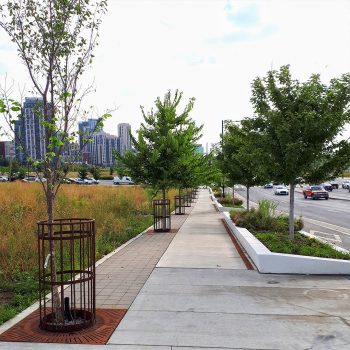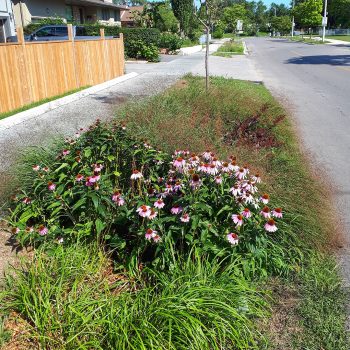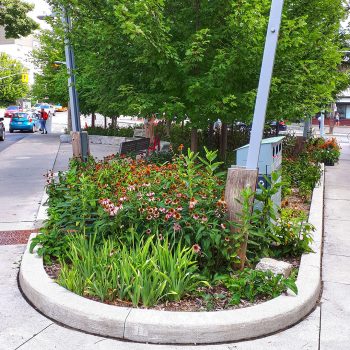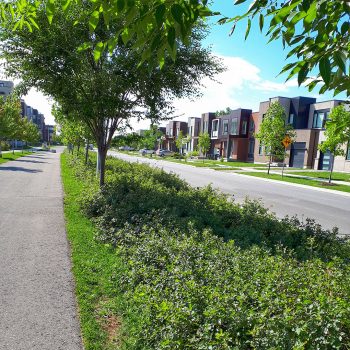
A number of green streets projects have been completed at various sites in the city and more are being planned. Green streets projects are completed either directly by the City or through Development led projects.
The Green Streets Map provides an overview of green infrastructure, assets that capture rainwater and direct it to plants and trees, that have been constructed throughout the City.
Review a description of green infrastructure types.
Planned road work is an opportunity for the City to consider whether a street is a suitable location for green streets. Bundling green streets work with other planned construction reduces construction costs and the overall disruption to the neighbourhood.
The City uses a technical screening process to identify and prioritize streets and locations in the right-of-way that are suitable for various types of green streets when road work is planned. A number of factors are considered in the evaluation, including:

Located along local roads in the mixed-used Etobicoke-Centre neighbourhood, this project was completed in 2020.
The City’s Official Plan identified Etobicoke Centre as one of four designated centres within the City and in 2003 the City initiated a Municipal Class Environmental Assessment (EA) of the Six Points Interchange to assess options for reconfiguration. The EA was conducted between 2003 and 2007 and included extensive public consultation. The overall reconfiguration provided an opportunity to introduce green streets elements, including stormwater tree trenches to support the growth of trees to maturation.
The Six Points Interchange Reconfiguration included a realignment of Dundas Street West, new traffic signals, widened sidewalks, three new streets, cycling facilities, new parkland, removal of two bridges, the creation of a district energy plan and inclusion of new street trees. New street trees were planted within stormwater tree trenches and continuous soil trenches along several streets. The stormwater tree trenches allow stormwater from the roadway to drain into catchbasins and this stormwater is redirected to the soils underneath the tree through a series of perforated pipes. The stormwater tree trenches provide benefits including reduction of the quantity of stormwater that enters the sewer system since it is redirected to the soils underneath the trees thereby increasing overall resilience to extreme storms.
The continuous soil trenches differ from the stormwater tree trenches in that there is no catchbasin connection, thus, road drainage is not captured. However, there is still an overall decrease in the quantity of stormwater that enters the sewer system as the impervious surface that existed previously (i.e. concrete or asphalt) has now been replaced with a pervious surface in the form of soils. Both stormwater tree trenches and continuous soil trenches provide other benefits including increased water quality through filtration through the soils, increased biodiversity and shade resulting in increased thermal comfort.
After the stormwater tree trenches were constructed, the contractor maintained the trees and any drainage infrastructure for a standard period of two years until the infrastructure was assumed by the City.
The City also works with the Sustainable Technologies Evaluation Program (STEP), which is led by the conservation authority, to monitor components of the stormwater tree trenches. STEP is currently monitoring the performance of the stormwater tree trenches to assess the stormwater volume retention capabilities of the system as well as the filtration capabilities.
Continuous soil trenches and stormwater tree trenches

Byng Avenue, a local road in a residential neighbourhood in Etobicoke, was completed in 2019.
Road rehabilitation was on the City’s Capital Program for construction and included reconstruction of the road and replacement of sidewalk. This presented an opportunity to bundle green streets scope into the already rehabilitation work.
In the areas where green streets infrastructure was proposed, there were no conflicting utilities or mature trees, which allowed for ease of construction of the green streets elements.
This project included the installation of two major green streets components; bioretention planters and a porous concrete sidewalk. These reduced the volume of stormwater that enters the sewer system, thereby increasing overall resilience to extreme storms and enhanced water quality through filtration through the bioretention media. The bioretention planters also include native plantings that increase biodiversity.
After the bioretention facilities and porous concrete sidewalk were constructed, the contractor maintained the horticulture and any drainage infrastructure for a standard period of two years until the infrastructure was assumed by the City. After that period, the City has been maintaining the drainage infrastructure and adjacent property owners have been maintaining the horticulture (i.e. watering, weed removal, litter removal).
Since this was the first location within the City where a permeable sidewalk was installed, the City took additional steps to ensure there was adequate monitoring of this green street feature. The City hired a consultant to oversee pre-construction and post-construction monitoring. The post-construction monitoring included assessment of the infiltration rates of stormwater through the porous concrete.

This project was completed in 2015 at the intersection of Fairford Avenue and Coxwell Avenue, in a mixed-use East York neighbourhood.
As part of the City’s Capital Program, intersection modifications were proposed at Fairford Avenue and Coxwell Avenue due to concerns about pedestrian safety.
Prior to construction, there was a right turn lane from Fairford Avenue going eastbound towards Coxwell Avenue. The intersection modification design included the elimination of the right turn channel and the construction of a new parkette. The parkette design included bioretention planters with shrubs and trees.
The bioretention planters provide a number of benefits including reduction of the quantity of stormwater that enters the sewer system thereby increasing overall resilience to extreme storms and enhanced water quality through filtration through the bioretention media. The bioretention planters also provide enhanced biodiversity through the horticulture and shade from trees resulting in increased thermal comfort.
A new seating area and bike parking were also constructed
After the bioretention planters were constructed, the contractor maintained the trees, shrubs and any drainage infrastructure for a standard period of two years until the infrastructure was assumed by the City.
The City has taken over maintenance of the systems, including watering, litter removal, weed removal, and overall maintenance of the drainage pipes.
Bioretention
As of May 2022, the Toronto Green Standard Version 4 came into effect and requires that all newly constructed streets include green infrastructure to capture and control stormwater to the maximum extent possible.

Stanley Greene Boulevard, a local road in a residential neighbourhood located south of Downsview Park, was completed in 2020.
The construction of green streets systems were included as part of the development proposal for the Stanley Greene subdivision. The location was proposed by the applicant for the development and reviewed and approved by City staff.
The project included the construction of a new street, which included a sidewalk on the west side of the street and a multi-use trail on the east side of the street.
The roadway and multi-use trail were separated by a bioswale, which provides a number of benefits including reduction of the quantity of stormwater that enters the sewer system thereby increasing overall resilience to extreme storms. The design also allowed for the elimination of catchbasins on the west side of the street as a significant volume of stormwater could be captured within the bioswale. The bioswale also provides enhanced water quality through filtration through the bioswale media. The bioswale also provides a physical buffer between the multi-use trail and the roadway, increasing pedestrian safety.
The applicant for a development is typically responsible for maintaining a constructed asset for a period of two years after the work is deemed completed. This period was extended to five years as this was one of the first bioswales constructed in Toronto and this extension ensured there was sufficient time for it to become established.
The City will take over maintenance responsibilities after the five year period.
Bioswale